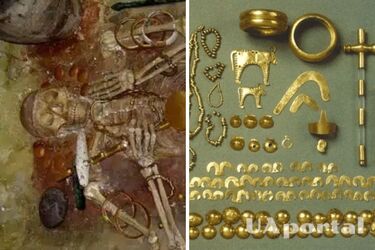Tomb of the 5th millennium BC full of golden artifacts found in Bulgaria: the most important archaeological find in the country's history

In the 1970s, a significant archaeological discovery was made in Bulgaria that revealed many ancient secrets. The tomb, which belonged to the richest in the country's history and dated back to the 5th millennium BC, contained a treasure trove of gold artifacts, making this discovery one of the most significant in Bulgarian archaeology, GreekReporter writes.
Excavations conducted by Raicho Marinov in 1970-1990 helped to uncover the secrets of an advanced society known as the Varna culture. Some graves stood out as "symbolic" graves, with no skeletons but lots of gold and jewelry.
In Tomb 43, archaeologists discovered the remains of a high-ranking man, a likely ruler, with a large amount of gold, indicating a structured hierarchy in the culture's society.
Large-scale excavations between 1972 and 1991 resulted in the discovery of more than 22,000 artifacts, including more than 3,000 pieces of gold. This ancient civilization, older than Mesopotamia and Egypt, was impressive for its skills in making gold artifacts between 4600 and 4200 BC.
The emergence of gold craftsmanship in Varna led to the transformation of society, creating an effective trade network with neighboring regions. The settlement of Varna became an important trading center with a convenient harbor for ships crossing the Black Sea. This economic development led to the formation of social classes, with metallurgists at the top, merchants and farmers.
The influence of Varna culture was significant and went far beyond its time, shaping Europe for millennia. Grave rites in Varna indicate a social hierarchy, and artifacts show the presence of powerful rulers or kings.
Read also: Human remains 10,000 years old discovered in Vietnam for the first time (photo)
One of the most significant burials, that of a man from Varna, contained huge gold jewelry that symbolized his high status or spiritual power. It was the first known elite male burial in Europe, and it disrupted existing ideas about matriarchal societies. Archaeologist Maria Gimbutas has suggested that the shift in favor of male dominance occurred in the late fifth millennium BC.
The graves also indicate the religious beliefs and practices of Varna culture. The different positions of men and women in the graves, as well as the golden amulets symbolizing femininity and related to pregnancy, provide important information about this people.
As a reminder, the perfectly preserved remains of a man who died in the tsunami 3600 years ago were found in Greece.
If you want to get the latest news about the war and events in Ukraine, subscribe to our Telegram channel!
